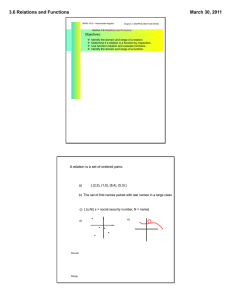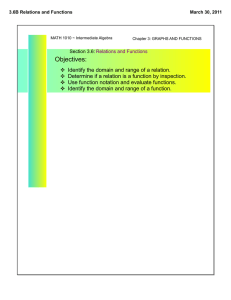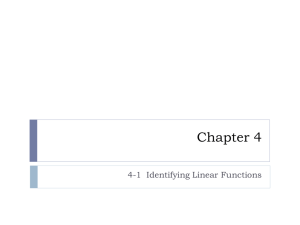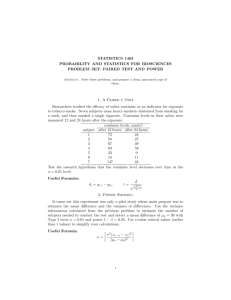Method Abstract
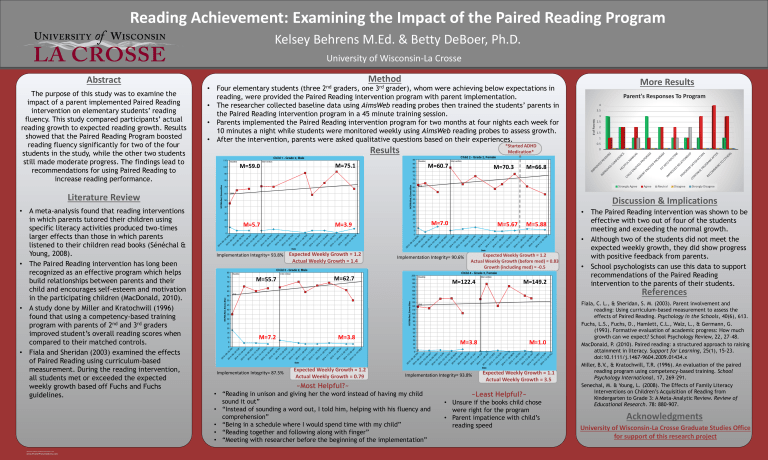
Reading Achievement: Examining the Impact of the Paired Reading Program
Kelsey Behrens M.Ed. & Betty DeBoer, Ph.D.
University of Wisconsin-La Crosse
Abstract
The purpose of this study was to examine the impact of a parent implemented Paired Reading intervention on elementary students’ reading fluency. This study compared participants’ actual reading growth to expected reading growth. Results showed that the Paired Reading Program boosted reading fluency significantly for two of the four students in the study, while the other two students still made moderate progress. The findings lead to recommendations for using Paired Reading to increase reading performance.
Literature Review
• A meta-analysis found that reading interventions in which parents tutored their children using specific literacy activities produced two-times larger effects than those in which parents listened to their children read books (Sénéchal &
Young, 2008).
• The Paired Reading intervention has long been recognized as an effective program which helps build relationships between parents and their child and encourages self-esteem and motivation in the participating children (MacDonald, 2010).
• A study done by Miller and Kratochwill (1996) found that using a competency-based training program with parents of 2 nd and 3 rd graders improved student’s overall reading scores when compared to their matched controls.
• Fiala and Sheridan (2003) examined the effects of Paired Reading using curriculum-based measurement. During the reading intervention, all students met or exceeded the expected weekly growth based off Fuchs and Fuchs guidelines.
Method
• Four elementary students (three 2 nd graders, one 3 rd grader), whom were achieving below expectations in reading, were provided the Paired Reading intervention program with parent implementation.
• The researcher collected baseline data using AimsWeb reading probes then trained the students’ parents in the Paired Reading intervention program in a 45 minute training session.
• Parents implemented the Paired Reading intervention program for two months at four nights each week for
10 minutes a night while students were monitored weekly using AimsWeb reading probes to assess growth.
• After the intervention, parents were asked qualitative questions based on their experiences.
*Started ADHD
Results
Medication*
M=59.0
M=75.1
M=60.7
M=70.3
M=66.8
M=5.7
Implementation Integrity= 93.8%
Expected Weekly Growth = 1.2
Actual Weekly Growth = 1.4
M=55.7
M=7.2
M=3.9
M=62.7
M=3.8
M=7.0
Implementation Integrity= 90.6%
Expected Weekly Growth = 1.2
Actual Weekly Growth (before med) = 0.83
Growth (including med) = -0.5
M=122.4
M=149.2
M=3.8
M=5.67
M=5.88
M=1.0
Implementation Integrity= 87.5%
Expected Weekly Growth = 1.2
Actual Weekly Growth = 0.79
Implementation Integrity= 93.8%
~Most Helpful?~
• “Reading in unison and giving her the word instead of having my child sound it out”
• “Instead of sounding a word out, I told him, helping with his fluency and comprehension”
• “Being in a schedule where I would spend time with my child”
• “Reading together and following along with finger”
• “Meeting with researcher before the beginning of the implementation”
Expected Weekly Growth = 1.1
Actual Weekly Growth = 3.5
~Least Helpful?~
• Unsure if the books child chose were right for the program
• Parent impatience with child’s reading speed
4
3.5
3
2.5
2
1.5
1
0.5
0
More Results
Parent's Responses To Program
Strongly Agree Agree Neutral Disagree Strongly Disagree
Discussion & Implications
• The Paired Reading intervention was shown to be effective with two out of four of the students meeting and exceeding the normal growth.
• Although two of the students did not meet the expected weekly growth, they did show progress with positive feedback from parents.
• School psychologists can use this data to support recommendations of the Paired Reading intervention to the parents of their students.
References
Fiala, C. L., & Sheridan, S. M. (2003). Parent involvement and reading: Using curriculum-based measurement to assess the effects of Paired Reading. Psychology in the Schools , 40(6), 613.
Fuchs, L.S., Fuchs, D., Hamlett, C.L., Walz, L., & Germann, G.
(1993). Formative evaluation of academic progress: How much growth can we expect? School Psychology Review, 22, 27–48.
MacDonald, P. (2010). Paired reading: a structured approach to raising attainment in literacy. Support for Learning , 25(1), 15-23. doi:10.1111/j.1467-9604.2009.01434.x
Miller, B.V., & Kratochwill, T.R. (1996). An evaluation of the paired reading program using competency-based training. School
Psychology International , 17, 269–291.
Senechal, M. & Young, L. (2008). The Effects of Family Literacy
Interventions on Children’s Acquisition of Reading from
Kindergarten to Grade 3: A Meta-Analytic Review. Review of
Educational Research . 78: 880-907.
Acknowledgments
University of Wisconsin-La Crosse Graduate Studies Office for support of this research project
RESEARCH POSTER PRESENTATION DESIGN © 2012 www.PosterPresentations.com


